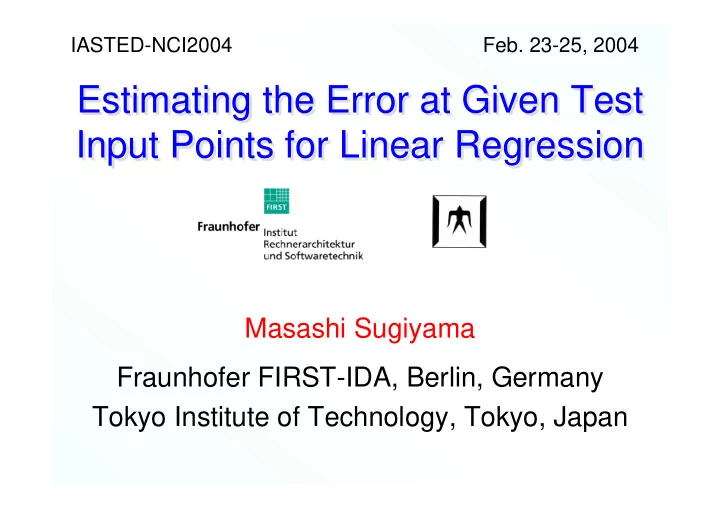

IASTED-NCI2004 Feb. 23-25, 2004 Estimating the Error at Given Test Estimating the Error at Given Test Input Points for Linear Regression Input Points for Linear Regression Masashi Sugiyama Fraunhofer FIRST-IDA, Berlin, Germany Tokyo Institute of Technology, Tokyo, Japan
2 Regression Problem Regression Problem :Underlying function :Learned function L :Training examples L (noise) From , obtain a good approximation to
3 Typical Method of Learning Typical Method of Learning � Linear regression model :Parameters :Fixed basis functions � Ridge estimation :Ridge parameter (model parameter)
4 Model Selection Model Selection Underlying function Learned function is too small is appropriate is too large Choice of the model is crucial for obtaining good learned function !
5 Generalization Error Generalization Error For model selection, we need a criterion that measures ‘closeness’ between and : Generalization error, e.g., :Probability density Determine the model of test input points so that an estimator of the unknown generalization error is minimized.
6 Transductive Inference Transductive Inference � Test input points are specified in advance. � We do not have to estimate the entire function , but just estimate the values of the function at the test input points .
7 Model Selection Model Selection for Transductive Inference for Transductive Inference � Test error at given test input points is different from the generalization error. � Model should be chosen so that the test error only at is minimized. Small generalization error Large generalization error Large test error Small test error
8 Goal of Our Research Goal of Our Research � We want to estimate the test error at the given test input points! :Expectation over noise
9 Setting Setting � Linear regression model :Parameters :Fixed basis functions � Linear estimation :A matrix � Realizability :Unknown true parameters
10 Bias / Variance Decomposition Bias / Variance Decomposition Bias Variance Bias Variance
11 Tricks for Estimating Bias Tricks for Estimating Bias Sugiyama & Ogawa (Neural Comp., 2001) Sugiyama & Müller (JMLR, 2002) � True parameter is unknown. � We utilize an unbiased estimator of the true parameter for estimating the bias. :Design matrix :Generalized inverse
12 Unbiased Estimator of Bias Unbiased Estimator of Bias Bias Rough estimate
13 Unbiased Estimator of Variance Unbiased Estimator of Variance � :Noise variance � An unbiased estimator of noise variance: �
14 Unbiased Estimator of Test Error Unbiased Estimator of Test Error � Adding bias and variance estimators, we have an unbiased estimator of test error. � For simplicity, we ignore constant terms
15 Unrealizable Cases Unrealizable Cases � So far, we assumed that the model includes the underlying function. :Unknown true parameters � We can prove that even when the above assumption is not rigorously fulfilled, is still almost unbiased.
16 Simulation: Toy Data Sets Simulation: Toy Data Sets � Basis functions: 10 Gaussian functions centered at equally located points in . � Target function: sinc-like function (realizable). � Training examples : � Test input points : � Ridge estimation is used for learning.
17 :Ridge parameter Results (1) Results (1)
18 :Ridge parameter Results (2) Results (2)
19 Simulation: DELVE Data Sets Simulation: DELVE Data Sets � Training set: 100 randomly selected samples. � Test set: 50 randomly selected samples. � Basis functions: Gaussian function centered at first 50 training input points. � Ridge estimation is used for learning. � Ridge parameter is selected by the proposed method, leave-one-out cross-validation, or an empirical Bayesian method.
20 Normalized Test Errors Normalized Test Errors Mean (Standard deviation) Proposed LOO cross- Empirical Data set method validation Bayes Boston 1.17 (0.54) 1.26 (0.58) 1.39 (0.59) Bank-8fm 1.07 (0.29) 1.11 (0.32) 1.09 (0.31) Bank-8nm 1.09 (0.51) 1.12 (0.56) 1.18 (0.60) Kin-8fm 1.06 (0.32) 1.17 (0.36) 1.68 (0.48) Kin-8nm 1.11 (0.27) 1.09 (0.24) 1.15 (0.24) Red: Best and others with no significant difference by 99% t-test Proposed method can be successfully applied to transductive model selection!
21 Conclusions Conclusions � Model selection is usually carried out so that estimated generalization error is minimized. � When test input points are specified in advance (transductive inference), it is natural to choose a model so that the test error only at the test input points is minimized. � We derived an unbiased estimator of the test error at given test input points. � Simulation showed the proposed method works well in practical situations.
Recommend
More recommend